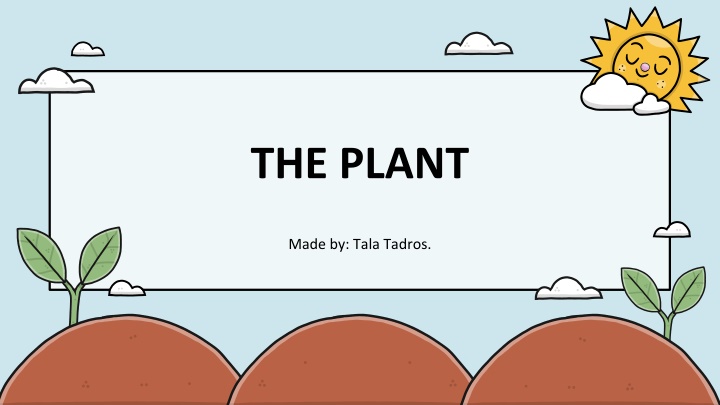
Understanding Plant Life: From Growth to Photosynthesis
Explore the world of plants with insights on planting, caring, parts of flowers, leaf versus stem plants, cotton plant details, and the process of photosynthesis. Learn about seeds, germination, transplanting, potting, plant care tips, and the importance of factors like temperature, humidity, pH, and water for optimal plant growth.
Download Presentation

Please find below an Image/Link to download the presentation.
The content on the website is provided AS IS for your information and personal use only. It may not be sold, licensed, or shared on other websites without obtaining consent from the author. If you encounter any issues during the download, it is possible that the publisher has removed the file from their server.
You are allowed to download the files provided on this website for personal or commercial use, subject to the condition that they are used lawfully. All files are the property of their respective owners.
The content on the website is provided AS IS for your information and personal use only. It may not be sold, licensed, or shared on other websites without obtaining consent from the author.
E N D
Presentation Transcript
THE PLANT Made by: Tala Tadros.
TABLE OF CONTENTS 01 02 03 Leaf vs stem plants Parts of a flower Planting a plant 04 05 06 Plant kinds around the world Cotton plant Photosynthesis
PLANTING SEEDS GERMINATING TRANSPLANTING POTTING When a plant or tree removed from one location and reset in the ground at another The sprouting of a seed, spore usually after a period of dormancy Planting a plant in a pot.
PLANT CARES TEMPERATURE HUMIDITY PH WATER The perfect temperature for most plants to grow is 21-24 degrees Celsius. The pH range 5.5 6.5 is optimal for plant growth Rainwater and bottled spring water are the best options. An ideal humidity level for most adult plants is 60% to 70%.
PARTS OF A FLOWER LEAVES The leaves collect energy from the Sun and make food for the plant, using photosynthesis. PETAL To attract pollinators and to protect the reproductive parts of a flower. SEEDS STEM The stem supports the plant above ground, and carries the water and minerals to the leaves. The part that develops from the ovules after fertilization, to create ROOTS offspring. The roots absorb water and minerals from the soil and anchor the plant in the ground.
Leaf vs stem plants STEM PLANTS LEAF PLANTS It s the typical plant you see everyday. the stem conducts water, minerals, and food to other parts of the plant; it may also store food, and green stems themselves produce food. Examples are celery, asparagus, rhubarb and turmeric. Leaf plants have short/ non visible stems whilst it has large leaves which leave more room for photosynthesis and food production. Spinach, lettuce, silverbeet, brussel sprouts and witloof are examples of leaf plants.
THE COTTON PLANT COTTON Where the cotton is obtained. After maturing, the bolls burst open and the seeds covered with cotton fibers can be seen FLOWER STEM To support the cotton boll.
THE PHOTOSYNTHESIS What is it? Photosynthesis is the process by which plants use sunlight, water, and carbon dioxide to create oxygen and energy in the form of sugar. How? Plants take in carbon dioxide and water from the air and soil. Within the plant cell, the water is oxidized, while the carbon dioxide is reduced. This transforms the water into oxygen and the carbon dioxide into glucose.
COUNTRIES WITH THE MOST KINDS OF PLANTS IN THE WORLD Chart Different types BRAZIL It has 34,387 kinds of plants COLOMBIA CHINA It has 31,362 kinds of plants MEXICO It has 24,025 kinds of plants It has 23,385 kinds of plants
Questions! What are the four factors for plant care? pH, water, temperature, humidity. Which 2 countries have the most variety of plants Brail and china.
THANK YOU Slidesgo CREDITS: This presentation template was created by Slidesgo, including icons by Flaticon, infographics & images by Freepik Flaticon Freepik
